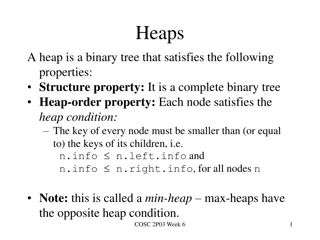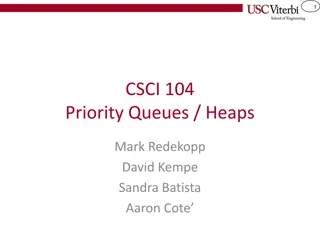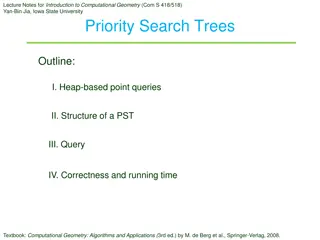Combining Graph Algorithms with Data Structures and Algorithms in CSE 373 by Kasey Champion
In this lecture, Kasey Champion covers a wide range of topics including graph algorithms, data structures, coding projects, and important midterm topics for CSE 373. The lecture emphasizes understanding ADTs, data structures, asymptotic analysis, sorting algorithms, memory management, P vs. NP, heap
3 views • 38 slides
Heaps and Multi-way Search Trees
Explore the concepts of heaps, types of heaps, and their applications, along with the implementation of different heaps and indexing techniques. Learn about the differences between B-trees and B+-trees in the context of data structures.
0 views • 60 slides
Heaps in Binary Trees
Heaps are binary trees that adhere to specific properties, such as being complete and satisfying the heap-order property. This involves nodes having keys smaller than or equal to their children. Key operations like removeMin and insert can be performed on heaps efficiently. Array implementations all
0 views • 10 slides
Heaps - A Comprehensive Overview
Heaps are hierarchical data structures that prioritize the most important elements for quick access. This article explores the concept of heaps, types of heaps (such as min and max heaps), abstract data type, practical uses over binary search trees, storing heaps in memory with arrays, manipulations
0 views • 17 slides
Priority Queues and Heaps in Java Collections
Explore the concepts of priority queues, heaps, and related data structures in Java Collections Framework. Learn about the Priority Queue class, Entry ADT, Comparator ADT, and Total Order Relations, along with their practical applications in process scheduling and more.
0 views • 44 slides
Heaps and Priority Queues in Data Structures
Exploring the concepts of heaps, priority queues, and the Priority Queue ADT in the context of data structures. Topics include the implementation of priority queues, comparing different data structures for efficiency, and the behavior of operations like insert and removeMin.
0 views • 40 slides
Priority Queues and Heaps in Java
Explore the concepts of priority queues, heaps, and their implementations in Java. Learn about efficiency tradeoffs, interface vs. implementation, and the primary operations of priority queues. Discover the importance of comparable elements and the various data structures used for efficient operatio
0 views • 49 slides
Priority Queues and Heaps in Data Structures
Priority queues prioritize item retrieval based on value, contrasting with traditional queues that follow a first-in-first-out approach. Priority queues efficiently manage items based on their importance, often utilized in scenarios like emergency rooms or air traffic control. Heaps, a form of binar
0 views • 20 slides
Comprehensive Overview of Binary Heaps, Heapsort, and Hashing
In this detailed review, you will gain a thorough understanding of binary heaps, including insertion and removal operations, heap utility functions, heapsort, and the efficient Horner's Rule for polynomial evaluation. The content also covers the representation of binary heaps, building initial heaps
0 views • 24 slides
Priority Queues and Heaps in Data Structures
Priority Queues are data structures that support operations like Enqueue, Dequeue, Insert, and deleteMin, where elements are ordered based on priority. This article covers various aspects of Priority Queues, including their implementation, applications in operating systems, and the concept of Binary
0 views • 25 slides
Quick Overview of Heaps: Implementation and Properties
The tutorial covers the basics of heaps, focusing on their implementation using arrays and key properties such as Heap-Order Property and Complete Binary Tree Property. It also includes multiple-choice questions to test understanding. Learn about the efficient use of heaps for insertions, removals,
0 views • 12 slides
Data Structures and Heaps in Computer Science - Lecture 10 Overview
Explore the concept of heaps and heapsort in data structures, focusing on the binary heap data structure as an array object that resembles a nearly complete binary tree. Learn about binary tree representations, heap properties, and vertex assignments in a linear array to enhance search efficiency. U
1 views • 33 slides
Binary Heaps: Concepts and Implementations
Delve into the world of binary heaps with a focus on insertion, deletion, and analysis. Explore the implementation of binary heaps through insightful visual aids and exercises to enhance your understanding of this fundamental data structure.
0 views • 22 slides
Fibonacci Heaps and Operations
Fibonacci heaps are a type of data structure that supports efficient operations such as insertion, deletion, and finding the minimum key. They consist of heap-ordered trees rooted but unordered. Each node points to its parent, children, and siblings. The potential function and unordered binomial tre
0 views • 31 slides
Binary Heaps: Efficient Data Structure for Priority Queue Operations
Explore the concept of binary heaps, a specialized type of binary tree that allows for quick retrieval of the smallest (or largest) element. Learn how binary heaps excel in finding the minimum value, essential for priority queue applications in operating systems, event simulations, and more. Compare
2 views • 34 slides
Soft Heap and Soft Sequence Heaps: Properties and Applications
Explore the properties and applications of Soft Heap and Soft Sequence Heaps, discussing how corruption handling and selection functions are optimized in these data structures. The concept of car-pooling and the simplification of heap operations are highlighted, along with references to relevant res
1 views • 10 slides
Implementing a Priority Queue with Heaps
Learn about implementing a priority queue using heaps. Priority queues are essential data structures that maintain a special ordering property. The use of binary trees and heaps is explained in detail, focusing on maintaining shape and heap properties during insertions.
0 views • 57 slides
Heaps: A Fundamental Data Structure in Programming
Alan Perlis' quote emphasizes the certainty that comes with programming, showcasing the progression from learning to teaching. The concept of heaps, a type of binary tree data structure, is explored in this material. Heaps maintain a hierarchical order, with the root of the tree containing the minim
0 views • 27 slides
Overview of Soft Sequence Heaps in Algorithms
Soft sequence heaps are a specialized data structure designed to handle corruptions in heap operations efficiently. This technology, introduced at Aarhus University, simplifies heap manipulation, particularly in car-pooling and other applications, with a focus on minimizing corruptions during extrac
0 views • 10 slides
Heaps: A Complete Binary Tree Data Structure
Introduction to heaps, a special type of complete binary tree used for efficient priority queue implementation and sorting. Explains the concept of maxheap and minheap, along with operations like isEmpty, getNumberOfNodes, getHeight, peekTop, add, and remove. Includes visual aids and definitions to
5 views • 47 slides
Selection in Heaps and Row-Sorted Matrices Using Soft Heaps
Generalized selection involves finding the ?-th smallest item from a totally ordered domain with a known partial order. Various interesting selection problems are discussed, including selecting the ?-th smallest item in a heap using both trivial and non-trivial algorithms. The comparison between hea
0 views • 34 slides
Abstract Domains for Lists and Heap Structures: A Comprehensive Overview
Explore the concepts of quantified data automata on skinny trees, automatic shapes in static analysis, universally quantified properties on lists, heap configurations with skinny trees, and the extension of quantified data automata over lists. Dive into the abstract domain of automata to capture inf
1 views • 20 slides
Priority Queues in Java: Implementation and Use Cases
Explore the concept of priority queues in Java, covering implementations using unsorted and sorted linked lists, as well as heaps. Learn about the differences between a queue and a priority queue through reading quizzes and discover various priority queue implementation options. Dive into priority q
1 views • 42 slides
Heapsort and Heaps: A Generic Algorithm for Sorting
This content discusses the concept of heapsort and heaps in the context of sorting algorithms. It covers a generic algorithm for sorting a sequence of numbers in non-decreasing order, detailing different implementations and time requirements for inserting and removing elements from a set. A clever c
0 views • 50 slides
Heaps and Tries in Computer Science
Delve into the concepts of heaps and tries, which are crucial data structures in computer science. Learn about priority queues, heap properties, representation, implementation, operations such as insertion and deletion, calculating parent/child relationships, and building heaps. This topic covers es
0 views • 49 slides
Satisfiability Modulo Abstraction for Separation Logic with Linked Lists
This study explores the application of satisfiability modulo abstraction in separation logic with linked lists. It presents a technique using abstract interpretation concepts to handle separation logic formulas beyond previous methods, specifically focusing on over-approximating heaps that satisfy t
0 views • 41 slides
Text Processing: Indexing, Zipf's Law, and Vocabulary Growth
Processing text involves converting documents into index terms, addressing issues like word variations, indexing text and metadata, understanding word frequency distribution with Zipf's Law, and predicting vocabulary growth with Heaps' Law.
0 views • 30 slides
Introduction to Priority Search Trees in Computational Geometry
This lecture outlines the structure and query process of Priority Search Trees (PST) in computational geometry. It covers heap-based point queries, range trees for windowing queries, handling query ranges in 1D and 2D spaces, and using heaps to efficiently handle query ranges. The content discusses
1 views • 18 slides
Comprehensive Overview of Midterm Review Topics in Data Structures and Object-Oriented Design
Covering topics such as run-time analysis, linear data structures, recursion, trees, priority queues, heaps, maps, hash tables, dictionaries, iterative algorithms, loop invariants, software engineering principles, and important functions in algorithm analysis.
0 views • 86 slides
CSE 373 - Hashing Concepts and Exam Preparation
Introduction to hashing in CSE 373, covering basic concepts, hash functions, collision resolution, and runtimes. Exam details for Friday's practice exam include topics on Stacks, Queues, BigO Notation, Heaps, Trees, Design Tradeoffs, and exam format with emphasis on theoretical understanding. Lectur
1 views • 38 slides
Priority Queues: Operations and Implementations
Priority queues are data structures that allow efficient insertion, deletion, and retrieval of elements based on their priority. This information-rich content covers various aspects of priority queues, including ideal times, binomial queues, Dijkstra's algorithm for single-source shortest paths, and
0 views • 11 slides
Priority Queues and Heaps in CS2110
Delve into the realm of priority queues and heaps in the context of CS2110 during the Fall of 2015. Explore the differences between heaps and Binary Search Trees (BSTs) through desirable properties and advantages each structure offers. Discover how stacks and queues are implemented as restricted lis
1 views • 50 slides
Priority Queues and Heaps in Data Structures
Exploring the concepts of priority queues, heaps, and various data structures like linked lists, binary search trees, and interfaces like Bag. The content covers comparisons between BSTs and heaps, efficiency purposes in data structures, and implementations of stacks and queues. Learn about the sign
0 views • 50 slides
Debugging Tips for Carnegie Mellon's Malloc Lab
Explore essential debugging strategies for the Carnegie Mellon Malloc Lab, focusing on identifying errors, resolving segfaults, and implementing a heap checker to maintain well-formed heaps. Learn how to efficiently troubleshoot issues and improve your debugging skills in computer systems.
0 views • 19 slides
Implementing Heaps: Node Operations and Runtime Analysis
Understanding the implementation of heaps involves knowing various node operations like finding the minimum node, last node, next open space, children, and parent. The runtime analysis of heap operations such as peekMin, removeMin, and insert are crucial for optimizing performance. This recap covers
0 views • 9 slides
Priority Queues and Heaps in CSE 373 Lecture
Today's lecture in CSE 373 covers the Priority Queue Abstract Data Type (ADT), the properties of heaps, and their implementations. Key topics include the completeness property of heaps, different priority queue implementations such as the binary search tree for faster insert and find operations, and
0 views • 21 slides
Introduction to Data Structures in Computer Science
Storing and organizing data efficiently is key in computer science. Data structures such as lists, search trees, heaps, hashing, and more play a vital role in this process. Abstract data types like lists and stacks are fundamental concepts that help in managing data effectively.
0 views • 52 slides
Introduction to Proof by Induction in Data Structures and Algorithms
Explore the concept of proof by induction in the context of Data Structures and Algorithms. Understand the process of establishing a statement for all natural numbers using deductive steps, with examples and practical applications like AVL trees and heaps. Learn how to apply this technique to solve
0 views • 27 slides
Peer Instruction in Java: Enhancing Learning Experience
Explore the world of data structures through peer instruction in Java with Cynthia Lee. This approach involves interactive group discussions, problem-solving, and hands-on activities to deepen understanding of key concepts. The course covers topics such as ADTs, APIs, algorithm analysis, object-orie
0 views • 23 slides
Join the Green Team: A Corporate Environmental Program
Embrace sustainability with the Green Team's initiatives - company-wide recycling stations, compost heaps, carpool sign-ups, and more. Be a part of the solution and make a difference today in promoting a greener workplace!
0 views • 4 slides







































